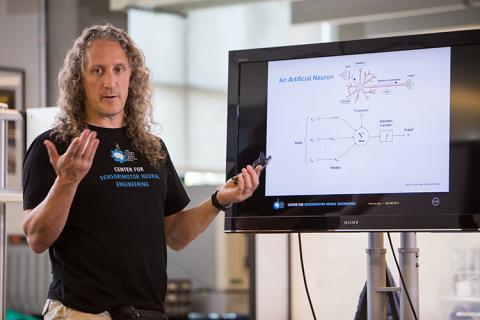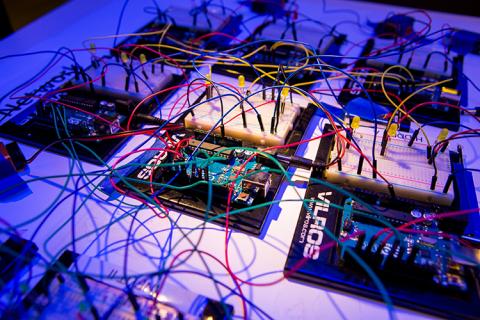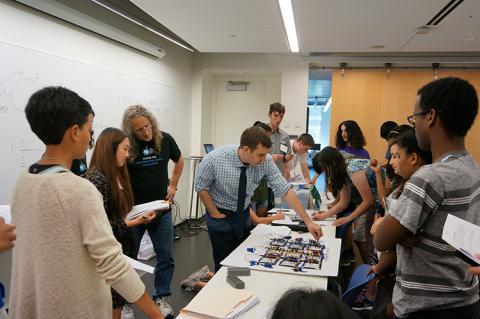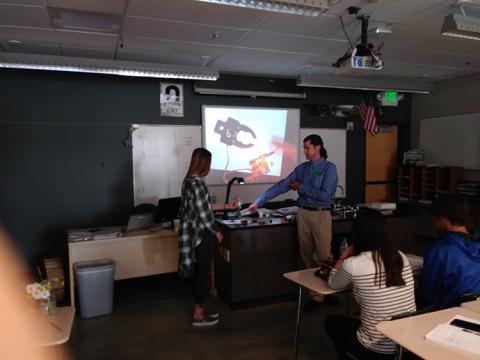Wayne Gillam
For over two years, high school teachers, Larry Bencivengo and Benjamin Hart, have been teaching and sharing neural engineering curriculum they developed together at the CNT. They are now poised to take their lesson plans to a national stage.
The old saying, “Give a man a fish, and he’ll eat for a day. Teach him how to fish and he’ll eat forever,” could be applicable to the Center for Neurotechnology’s (CNT’s) Research Experience for Teachers (RET) program. This six-week summer research program for middle and high school teachers on the University of Washington campus provides an intensive neural engineering research and curriculum development experience that results in broad, ongoing impacts on secondary students in the Puget Sound area and the state of Washington.

Now, the RET program is poised to take its knowledge-dissemination model a step further through two former RET participants, Larry Bencivengo and Benjamin Hart. These biology teachers from Mercer Island High School and Redmond High School, respectively, have remained actively connected with the CNT since completing the RET summer program in 2015. Together, they co-authored a curriculum unit for Advanced Placement (AP) Biology that is focused on building an artificial neural network using nine networked and programmed Arduinos, which are components used to construct interactive electronics.
Larry and Benjamin have really gone above and beyond to take me up on my encouragement to disseminate their curriculum more broadly.
–CNT Education Research Manager, Kristen Bergsman
In addition to piloting the curriculum in their own classrooms and sharing it on the CNT website, Bencivengo and Hart have returned to the CNT to teach other educators about their curriculum unit. Last summer, Bencivengo taught five RET participants how to build an artificial neural network, and he and Hart led a similar activity with YSP-REACH high school students.

“Larry and Benjamin have really gone above and beyond to take me up on my encouragement to disseminate their curriculum more broadly,” said CNT Education Research Manager, Kristen Bergsman. “They have shared their curriculum in multiple ways, and there is a layering happening from year to year as we build deeper relationships in the community, which in turn creates more opportunities.”
In October 2017, Bencivengo and Hart went to the Washington Science Teacher Association (WSTA) annual conference in Pasco, Washington to lead a session focused on their artificial neural network curriculum, and in March 2018 they will be leading a similar session at the National Science Teachers Association (NSTA) annual national conference in Atlanta, Georgia. These conferences are an opportunity to share a classroom-tested, ready-to-go curriculum unit with teachers who will take the lesson plans back to their own classrooms, and in effect, teach students across the country about neural engineering.
According to CNT Pre-College Education Manager and RET Program Manager, Janis Wignall, the need for building neural engineering knowledge among secondary students and the advantages of working directly with teachers to accomplish this are clear.
“We need engineers. We need students to become part of the work force. We need to support scientific literacy on a local and national scale, and it’s important to invest in this future. The CNT works with teachers who have a broad impact. Every teacher that we educate touches the lives of approximately 150 students a year,” Wignall said. “There’s a multiplier effect from investing time and energy into teachers, because they reach a lot of students. Then, those students get engaged and want to become neuroscientists and engineers. They get exposed to neural engineering through curriculum, they get exposed to new career options, and they get an opportunity to think about something that wasn’t previously on their radar screen.”

Impacts of the RET program
Although secondary science teachers do not normally teach neural engineering, they are required to teach some form of engineering design to meet the new Next Generation Science Standards. The RET program offers teachers like Bencivengo and Hart a way to meet these standards, while at the same time providing a hands-on research experience, guidance in designing neural engineering curricula and other professional development opportunities.
The CNT works with teachers who have a broad impact. Every teacher that we educate touches the lives of approximately 150 students a year.
–CNT Pre-College Education Manager, Janis Wignall
“The RET experience with the CNT was a fun challenge. I grew both personally and professionally by gaining experience in a research lab, being out of my comfort zone for a few months in a stimulating environment, remembering what it is like to be a student again—being the one asking the questions instead of the one providing the answers—and I met some truly amazing people, both in the lab and the other teachers in my cohort,” Bencivengo said. “The RET program led me fairly directly to applying for a Murdock Grant and continuing the experience of interning in a research lab for two more years. The partnership that Benjamin and I developed that summer has helped me to transition into a new phase in my career, giving me the confidence to share what I have been doing in my classroom with other teachers by presenting at WSTA and NSTA.”
The lesson plans teachers like Bencivengo and Hart develop through the RET program are thoroughly tested prior to wider dissemination by piloting them in RET participants’ classrooms. This piloting process also provides openings for further educational enrichment.

“My students benefited from my RET experience by having exposure to project-based learning that incorporated computer science,” Hart said. “Students also benefited from visits by CNT Co-Director, Dr. Chet Moritz. After I spent time working in his lab, Dr. Moritz taught an introductory lesson on neural engineering to my AP Biology students. Students could see first-hand how what they learn in high school connects to local research.”
Since its inception in 2012, the RET program has served 22 teachers, which translates to over 2,800 students who have been taught neural engineering. This statistic doesn’t even take into account the larger multiplier effect of teachers like Bencivengo and Hart sharing their curricula with other teachers locally, regionally and nationally. Perhaps most interestingly, over 64% of former RET participants still teach the curriculum unit they developed at the CNT, which given that teachers may change grade levels, class subjects and school districts, demonstrates an ongoing interest in neural engineering and the long-term value of this curricula.
The benefits of teachers sharing with other teachers
At six years old, the RET program is building momentum in terms of sharing its curriculum resources with a wider audience. According to Bergsman, this growing library of neural engineering curricula aimed at secondary school teachers and their students is large enough now to justify promoting its distribution at a national level. She also noted that the mentor-teacher model piloted by the CNT last year had been very successful in helping to prepare teachers to present at conferences like WSTA and NSTA.
“Having teachers come back for a second year helped them develop their confidence in presenting their curricula more widely and feeling like they could do it,” Bergsman said. “It’s scary to do that for the first time, to go in front of your peers and show an expertise in something.”
Wignall also noted the value of helping teachers distribute their neural engineering curricula themselves.
“Teachers are a cadre unto themselves, so when a teacher explains how to teach a unit, they know all the little nooks and crannies,” Wignall said. “They bring the finesse of how to teach units like these. They share what to teach, but perhaps more importantly, they also share how to teach it well.”
